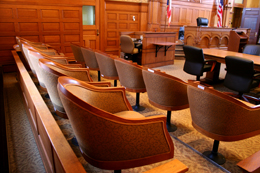Molineux Evidence And Domestic Violence: Testimony Of Prior Acts of Violence Are An Exception To Prohibition On Evidence Of Pior Bad Acts Where They Serve As Background About The Relationship or Establish Intent And Motive Of Defendant.
People v Frankline
New York Court of Appeals
2016 NY Slip Op 04441
Decided: June 9, 2016
Issue: Whether the court abused its discretion when it allowed a victim’s testimony about prior acts of violence against defendant that were an exception to the general prohibition on evidence of prior bad acts because it served as background about A.H.’s relationship with defendant, as well as proof of his intent and motive.
Holding: The Court of Appeals held that the evidence was admissible because it established the defendants motive. Previous acts of intimate partner violence may be nonpropensity evidence probative of a defendant’s motive and intent to assault the victim and which provides necessary background information on the nature of the defendant and victim’s relationship, People v Dorm, 12 NY3d 16, 19 (2009).
 Where there is a proper nonpropensity purpose, the decision whether to admit evidence of defendant’s prior bad acts rests upon the trial court’s discretionary balancing of probative value and unfair prejudice. A court’s decision whether to admit the evidence is reviewed for abuse of discretion (id.). An error in the court’s ruling, however, may be deemed harmless where the evidence of guilt is overwhelming and there is no significant probability that the jury would have acquitted but for the error, People v Crimmins, 36 NY2d 230, 241-242 (1975).
Where there is a proper nonpropensity purpose, the decision whether to admit evidence of defendant’s prior bad acts rests upon the trial court’s discretionary balancing of probative value and unfair prejudice. A court’s decision whether to admit the evidence is reviewed for abuse of discretion (id.). An error in the court’s ruling, however, may be deemed harmless where the evidence of guilt is overwhelming and there is no significant probability that the jury would have acquitted but for the error, People v Crimmins, 36 NY2d 230, 241-242 (1975).
Facts: At defendant’s trial on charges arising from his attempted murder and assault of his former intimate partner, A.H., she testified to an attack by defendant one week before the assault at issue. The court allowed this testimony as an exception to the general prohibition on evidence of prior bad acts because it served as background about A.H.’s relationship with defendant, as well as proof of his intent and motive.
On the stand, A.H. recounted how she and defendant came to live together, moved to Niagara County from New York City, and that sometime later she decided to leave defendant. However, when she returned to their apartment to pick up her possessions, defendant confronted her and words escalated to violence. A.H. described in detail how defendant physically, mentally, and sexually abused her, poured gasoline on her, and threatened to light her on fire. She eventually managed to escape, and reported the attack to the police before returning with her mother to New York City. A.H. next described that defendant broke into her mother’s home in New York City, and again beat her, doused her with gasoline, and attempted to ignite lighters in front of her.
 The court provided the jury with three sets of limiting instructions regarding this evidence; the first immediately preceding A.H.’s testimony about the Niagara County attack, the second at the conclusion of her testimony, and then once more during the court’s final jury charge.
The court provided the jury with three sets of limiting instructions regarding this evidence; the first immediately preceding A.H.’s testimony about the Niagara County attack, the second at the conclusion of her testimony, and then once more during the court’s final jury charge.
Each time the court informed the jury that the testimony concerning the Niagara County attack was introduced solely to provide background regarding the relationship between defendant and A.H., that the People contended it was proof of defendant’s intent and motive, that the testimony was not evidence of defendant’s propensity to commit the crimes charged, nor sufficient to convict defendant of those New York City crimes, and that the People had the burden to prove beyond a reasonable doubt all elements of those charged crimes.
The jury convicted defendant of attempted murder in the second degree, Penal Law 110.00, 125.25, assault in the third degree, Penal Law 120.00 (1), two counts of burglary in the first degree, Penal Law 140.30 (2), (3), and endangering the welfare of a child, Penal Law 260.10 (1). The Appellate Division affirmed (123 AD3d 504 [1st Dept 2014]), and a Judge of this Court granted defendant leave to appeal (25 NY3d 1072 (2015) and affirmed.
Legal Analysis: The Court of Appeals held that a court’s decision whether to admit the evidence is reviewed for abuse of discretion (id.). An error in the court’s ruling, however, may be deemed harmless where the evidence of guilt is overwhelming and there is no significant probability that the jury would have acquitted but for the error, People v Crimmins, 36 NY2d 230, 241-242 (1975).
Where the background evidence is of such nature and amount that a court cannot state with any conviction that evidence heard by a jury is not prejudicial to a defendant, any substantial doubt on where to strike a neat balance between possible prejudice to the defendant, and the indispensability of the challenged evidence to the People’s case should weight the scales in favor of the defendant (id. at 147). Where testimony does not help the jury to understand the defendant’s actions, and instead embroils him in general reprehensible police corruption, it destroys the reasonable balance between the claimed importance of this background evidence and its potential for prejudicing the defendant’s case (id. at 145-147)
 The Court of Appeals held that the trial court did not abuse its discretion by failing to limit ?A.H.s testimony nor did that such error substantially prejudiced the defendant so as to foreclose a determination of harmlessness. A.H’s testimony concerned the same parties, and served the nonpropensity purpose of directly explaining her relationship with the defendant and his motive. Lastly, testimony that the defendant previously attacked A.H. would not have led the jury to marginalize, relegate to the background, or ignore the grievous nature of the New York City assault, which was characterized by physical violence and several failed attempts at immolation.
The Court of Appeals held that the trial court did not abuse its discretion by failing to limit ?A.H.s testimony nor did that such error substantially prejudiced the defendant so as to foreclose a determination of harmlessness. A.H’s testimony concerned the same parties, and served the nonpropensity purpose of directly explaining her relationship with the defendant and his motive. Lastly, testimony that the defendant previously attacked A.H. would not have led the jury to marginalize, relegate to the background, or ignore the grievous nature of the New York City assault, which was characterized by physical violence and several failed attempts at immolation.
The Court of Appeals held that there is no error that requires a reversal of defendant’s conviction.
